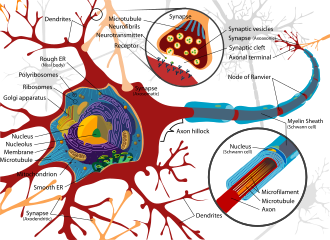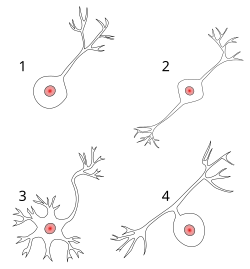General structure of nervous tissue
Nervous tissue is one of the basic types of tissue in the human organism. It contains two different types of cells: neurons and neuroglia.
Anatomically, nervous tissue can be divided into the central nervous system, containing the brain and spinal cord, and the peripheral nervous system, containing the nerves and nerve ganglia.
Neuron
Neuron is a functional and anatomical unit of the nervous system. Humans have 15-25 billion neurons and 300 billion contact surfaces, called synapses. A neuron is able to receive a particular form of signal and respond with special signals, conducting them and making special functional contacts (synapses) with other neurons, effectors or receptors.
Structure
A nerve cell consists of a body (soma, perikaryon) and two types of processes, afferent dendrites and efferent neurites (axons).
Soma
The body of the neuron is bounded by the plasma membrane, contains receptors and ion channels. This structure determines the generation and propagation of excitations. The body of the neuron contains the nucleus, Nissl substance (granular endoplasmic reticulum) and mitochondria.
Protrusions
Dendrites
Dendrites receive input information (at the same time it is a trophic segment). They are usually short, richly branched, and extended into dendritic spines that serve to modulate the postsynaptic potential as it transitions from synapse to dendrite. Neurochemically, they are very rich in chemically controlled ion channels.
Neurites
Neurites are long processes leading excitations from the body of the neuron (to the next neuron or effector), i.e. efferently. They contain ribosomes, a small number of mitochondria and neurotubules. Neurochemically, they are rich in voltage-gated ion channels. The site of neurite outgrowth is the axon bump; this, together with the initial segment of the neurite, is the site of action potential generation.
Myelinated neurites (= axones)
The myelinated section occurs along the entire length of the axon except for its beginning and terminal branching. It is important for the transmission of excitement, the thicker the axon, the faster the transmission. Throughout, the myelin sheath is interrupted by Ranvier notches, with the sections between each notch called internodes. The speed of conduction is directly proportional to the length of the internodes. In the PNS, the extracellular space at the site of the Ranvier notch is separated from the surroundings by a continuous basement membrane that bridges over the notch area; in the CNS, astrocyte processes are directly seated there.
Non-myelinated neurites
The main function of the neurite is the transport of certain substances from the body to the telodendrites, which is dependent on a developed system of neurofilaments and neurotubules. We distinguish between anterograde transport (from the cell body) and retrograde transport (into the cell body - spread of viruses and toxins).
Types of neurons
Neurons can be divided morphologically, according to the length of the axon and functionally.
- Morphological:
- multipolar (containing many small, richly branching dendrites);
- bipolar (contains one relatively long dendrite and axon, sensory neurons (skin, auditory, olfactory) and nociceptive fibres);
- unipolar;
- pseudounipolar (has a long dendrite that merges with the axon).
- According to the length of the axon:
- Golgi type I - neurons with long neurites;
- Golgi type II - neurons with short neurites.
- Functional:
- Principal (projection) - they connect distant areas of the nervous system;
- local (interneurons) - connect nearby areas.
Neuroglia
Glial cells function in the nutritive and structural support of neurons by controlling the neuronal microenvironment. In fact, they are more abundant than the neurons themselves. Different types are found in the CNS vs the PNS:
CNS neuroglia are mostly derived from cells in the neural tube. They all have small, dark, round nuclei. They include
- astrocytes: most abundant of the CNS glial cells
- many branching processes re-inforced by intermediate filaments (made of glial fibrillary proteins) form supporting scaffold
- many gap junctions
- several types:
- fibrous: many thin processes, predominate in white matter
- protoplasmic: shorter processes, predominate in grey matter
- radial (aka radial glia): guide and support differentiating neurons
- processes can associate and thus regulate synapses
- regulate ionic concentrations
- create blood-brain barrier via perivascular feet
- convert glucose to lactate
- processes form glial limiting membrane at the meninges
- form astrocytic scar tissue
- oligodendrocytes
- darker, round nucleus
- much RER and Golgi apparatus
- extend many processes, which become flat and form myelin sheaths (consisting of cell membrane) around axons
- neurons are not covered by neurilemma nor endoneurium in CNS (unlike in the PNS)
- microglia
- smallest of the neuroglia
- small, dark, elongated nuclei
- originate from monocytes in bone marrow
- phagocytose damaged or foreign substances
- ependymal cells
- columnar or cuboidal shape
- no basal lamina (unlike epithelium)
- line ventricles and central canal of CNS
- can have microvilli (absorption) and cilia (flow of CSF, which they secrete)
PNS neuroglia are derived from neural crest cells. They include
- Schwann cells
- noticeable nuclei
- form myelin sheath that covers large axons
- mesaxon noticeable afterward (edge-to-edge contact of parallel plasma membranes of a Schwann cell)
- unlike oligodendrocytes, cover only portion of an axon
- Satellite glial cells
- form a thin glial layer around large perikarya
- trophic function: insulation, nourishment, regulation of environment
Links
Related Articles
- Neuroglia
- Nervous tissue (physiology)
- Neuron
External links
- JANČÁLEK, Radim – OAK, Peter. Základy neurověd v zubním lékařství [online]. MEFANET, ©2011. [cit. 2011-11-26]. <http://portal.med.muni.cz/clanek-560-zaklady-neuroved-v-zubnim-lekarstvi.html>.
References
- CLIQUE, Eduard. Histology. 1. edition. Avicenum, 1986.
- – CARNEIRO, Jose – KELLEY, Robert O. Fundamentals of Histology. 1. edition. H & H, 1997. 502 pp. ISBN 80-85787-37-7.
- KONRÁDOVÁ, Václava – CARBON, George – VAJNER, Ludek. Funkční histologie. 2. edition. H & H, 2000. 291 pp. ISBN 80-86022-80-3.
- TROJAN, Stanislav. Lékařská fyziologie. 4. edition. Grada Publishing, a.s., 2003. ISBN 80-247-0512-5.




